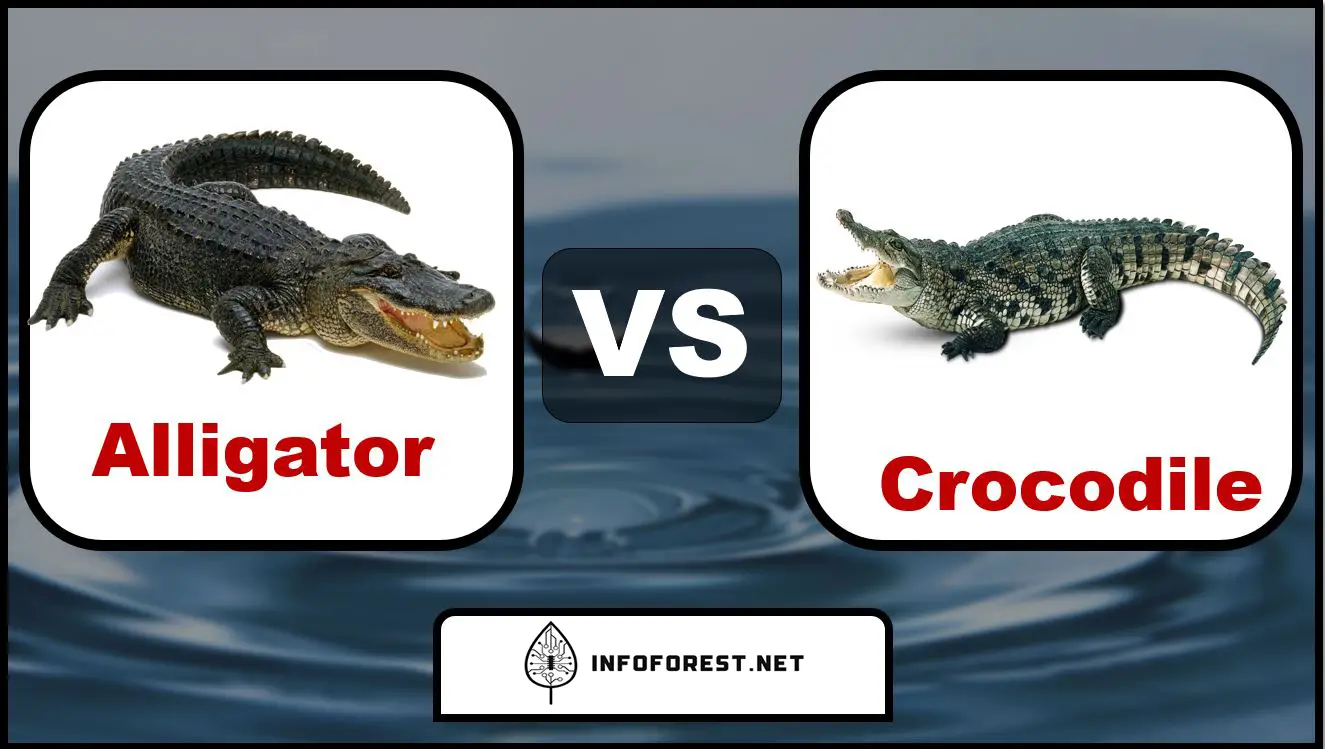
Since many people do not know the difference between alligators and crocodiles, they often use both expressions to refer to a giant water-dwelling lizard with large teeth. Both resemble lizards and are huge reptiles with long snouts, long tails, stocky legs, thick skin, and massive fangs. However, you can tell the two reptiles apart based on their unique characteristics. The main purpose of the Alligator vs Crocodile article is to examine the similarities and differences between these two animals.
We have created a comparison between the alligator and the crocodile so you can learn more about their physical characteristics, their feeding habits, and the threat they pose to humans, and figure out which animal would win in a fight. After reading this article, if you go to the zoo and see this animal from a reasonable distance, you will surely be able to tell if it is an alligator or a crocodile, and you will also be able to explain this animal’s behavior to your friends.
Alligator vs Crocodile – Color
One of the easiest ways to tell crocodiles from alligators is by their color: American crocodiles usually have white to golden undersides and are slate grey in color. This dark and light color is called countershading this allows them to blend in with the water when hunting. Most crocodiles that live in different parts of the world are either green, grey, brown, or black in color. They usually have a speckled or spotted pattern that makes it easier for them to blend in with the substrate and algae.
In comparison, alligators are often dark green to black. The American alligator has a glossy dark green color that can appear almost black under certain lighting conditions. Compared to a crocodile, it has a much darker color.
As with crocodiles, hues vary depending on habitat. Crocodiles usually live in open waters with high levels of algae. Therefore, they usually have a greener hue. Alligators often stay on the edges of lakes and rivers. Their color is said to blend in with the substrate and mud.
Alligator vs Crocodile – Hunting skills
Because of their exceptionally keen senses, both are excellent hunters. Both alligators and crocodiles are nightmares for their victims due to their keen overwater vision, night vision, strong hearing, and vertical pupils that absorb extra light.
God has gifted these animals with extraordinary powers of discernment. Both animals have tiny sensory pits along their jaws that allow them to detect and capture their prey by sensing pressure changes in the water. Both reptiles prefer to consume their prey whole or in large pieces rather than chewing them. Crocodiles can excrete more salt from water than alligators because they have salt glands that work more efficiently. Because of their weaker gland function, alligators are less able to tolerate a saltwater environment and prefer freshwater. This ability allows crocodiles to live and move more easily among marine objects.
Alligator vs Crocodile – Size and weight
The American alligator is the largest of the two alligator species and usually grows between 5 and 10 feet, but can reach up to 18 feet. The Chinese alligator is smaller, with an average length of 4 feet and a maximum length of 8 feet.
The largest and heaviest living reptiles are crocodiles. The largest species are the Australian estuarine crocodile (Crocodylus porosus) and the African Nile crocodile (Crocodylus niloticus); they can grow up to 22 feet long and weigh more than 1,200 kg each. The dwarf crocodile (Osteolaemus tetraspis) and the smooth-fronted caiman (Paleosuchus), the two smallest species, reach about 5 feet in length as adults.
Alligator vs Crocodile – Habitat
Crocodiles can tolerate brackish water better than alligators because they have functional salt glands on their tongues, while alligators prefer fresh water. This allows crocodiles to filter out salt easily. Alligators also have similar structures, but apparently are unable to use them to excrete large amounts of salt, so they prefer to stay in freshwater.
Most crocodile species are found in swamps and other wetlands near rivers and lakes. Because they can survive in salty waters, they occasionally migrate to fast-flowing streams, rivers, and canals. Generally, however, alligators stay near the coast. Most of their natural habitat consists of marshes, lakes, and low-flow riverbeds. They cannot survive in salty seas.
The American alligator inhabits more states than crocodiles due to temperature. Crocodiles need a higher temperature to survive, although both species are cold-blooded animals. They are found at temperatures between 80 and 95 °F. Before they go into hibernation, alligators can tolerate temperatures as low as 75 °F. Because they can survive in colder climates, alligators are more tolerant of lower temperatures.
Which one hunts humans?
Alligators prefer to run from humans, but crocodiles are often far more hostile. Many of the documented attacks by alligators on humans have occurred in bodies of water when humans accidentally imitate prey or when the alligator is actively foraging. In the U.S., they kill about one person per year.
Crocodiles, on the other hand, claim more than 1,000 lives a year in Africa alone. They are far more aggressive than alligators, and because of their enormous size, they have caused more fatal encounters than non-fatal attacks.
Most Viewed Articles
Which one hunts the other?
Although a clash between these two heavyweights is unlikely due to differences in population and geography, it is reasonable to assume that if the largest representatives of the two species were pitted against each other, the crocodile would win the fight. Alligators are faster on land and in water, but crocodiles are superior to them because of their size, biting power, and general aggressiveness. The crocodile’s keen senses and longer lifespan would certainly give it the strength needed to defeat an alligator, even if the two animals were the same size.
Comparison Table of Difference between Alligator and Crocodile
The table below lists the main differences between alligators and crocodiles. You can use this table to quickly get an overview of the entire article.
| Point of comparison | Alligator | Crocodile |
| Color | dark green to black | green, grey, brown |
| Habitat | Marshes, lakes, and low-flow riverbeds. They cannot survive in salty seas. | swamps and other wetlands near rivers and lakes |
| Size | 5 feet to 10 feet long | 12 feet to 22 feet long |
| Weight | 300lbs to 1000lbs | 500lbs to 1800lbs |
| Bite Strength | 13,000 N | 16,000 N |
| Speed on land | 35 mph | 25 mph |
| Speed in water | 25 mph | 15mph |
| Aggressiveness | Less aggressive | More aggressive |
| longevity | 20 – 55 years | 65 – 100 years |
| lower jaw’s teeth | Hidden | Visible |
| Risk of attack on humans | Moderate | high |
Summary
By now you should be able to tell the difference between an alligator and a crocodile. The most important thing to remember is that crocodiles and alligators are two different animals. You can tell them apart by jaw size, shape, and color. Crocodiles are more aggressive, larger, and have a v-shaped snout. They also have light green, brown, or light grey lower teeth that are visible. Alligators are smaller than crocodiles and have dark green or black skin, a u-shaped snout, and small black spots.
We also invite you not to miss our other popular articles such as Race vs Ethnicity, Difference between Developed Countries and Developing Countries, How long to boil Eggs, How Many Teaspoons in a Tablespoon, and Difference Between Management and Administration.










